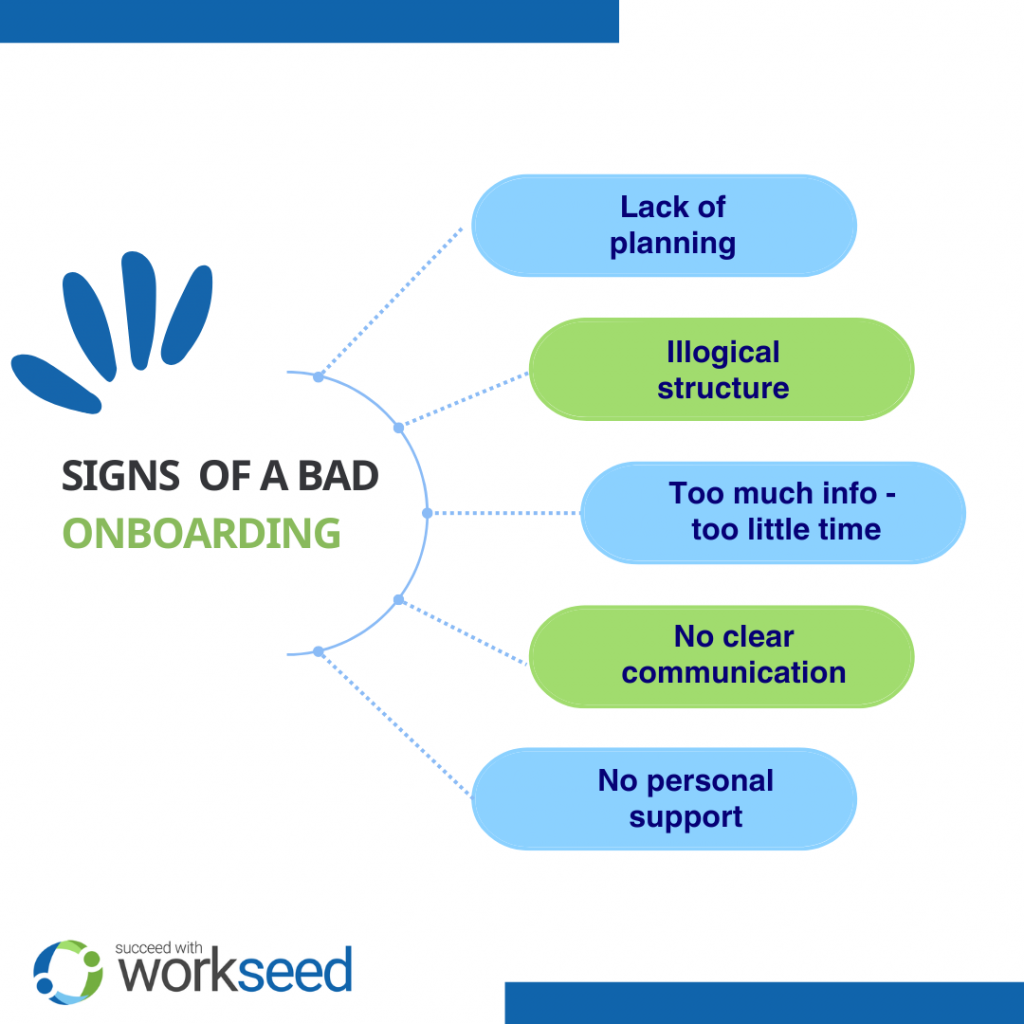Providing high-quality job onboarding for new employees is a challenge at best. When a lot of work is done in small teams, in multiple shifts, without a fixed workstation, or in a hybrid model, problems compound. Training coordinators have their work cut out for them.
When work is increasingly decentralized, training new employees can become tricky. Providing training online can be a flexible way to improve the quality of human resources management.
Poor onboarding process is likely to be costly for any organization on the long run.
This article takes a look at some common problems with new employee onboarding – and how digital onboarding can address them.
1. Training is insufficiently planned
Onboarding new employees should be a systematic and planned process. When there is no standard workflow, there is no steady quality in the workforce. Bad planning also contributes to illogical and insufficient training.
Digital onboarding on an online learning management system can help establish a clear standardized process for onboarding. It is not necessary to reinvent the wheel for each and every new recruitment. Rather, it can be beneficial to create a digital onboarding process that covers all the important topics in the same way for all the new employees.
This approach guarantees steady quality between all employees. It also reduces time spent on planning and executing onboardings, as well as makes quality control and iterative development of training possible.
2. New employees receive too much information at once – or none at all
Starting at a new job requires ingesting a lot of new information. Employees must understand the technical details of their job, adopt general practices of the organization, learn new information systems, follow security guidelines, and so on.
When training takes place face to face, detailed information must be repeated a number of times – people need much repetition to fully learn detailed information, after all. On the other hand there is a significant risk that important details are omitted by accident, or that the employee must actively ask for specific details during their work.
None of these alternatives are indicative of a good workflow.
When an LMS is applied to onboarding, it is possible to create a resource bank that employees can consult whenever they need. It is also possible to take training and consult study materials independently of time and place, even with a mobile device. Employees can carry all the relevant information in their pocket, all the time.
When the information is online, it is available as needed. There is never too much or too little guidance.
3. Insufficient communication and feedback
Any time a new employee needs help, guidance, or feedback, their supervisor needs to interrupt their own work to support them. If there is no proper workflow for guiding employees, the employee will likely receive insufficient feedback. This leads to underperformance and a sense of abandonment.
When training takes place online, the barrier for asking guidance can be lower. There is a flexible tool for communication, feedback, and exchanging ideas – even for decentralized or hybrid work. There is less need for face to face meetings and phone calls, or contact employees in case there are missed deadlines.
With digital onboarding, human resources management has better tools for managing the entire process of new employee onboarding, identifying problems, offering support, and meeting employee needs better.
4. Insufficiently defined goals
When little attention is paid to planning and understanding what new employees need, it is likely difficult to understand what is the purpose of onboarding workers. When there are no goals, it is difficult to make any progress. This leads to frustration and performance issues.
Online learning environment not only facilitates creating standardized digital onboarding programs, but also personal learning goals. It is easy for HR to define key skills and training modules, and for employees to understand what they need to achieve to be successful.
An LMS can also be used for managing competencies. Courses and digital onboarding programs can be connected to concrete competencies. It is easy to manage who has taken obligatory training modules and if needed, distribute certificates for completed courses. This makes managing learning transparent, for instance in case of an audit.
5. Onboarding is too short
When onboarding workflow is insufficient, onboarding is often too short – or there is no formal onboarding. Organizations may expect employees to simply pick up necessary skills on their own with minimal support. In reality, employees may never learn everything they need, which will drag down their productivity.
Digital onboarding is easy to scale and requires relatively little day-to-day input from supervisors, HR, and possible domain experts. Creating an online onboarding program has a fixed cost that does not vary based on how many employees are trained. It is also possible for employees to study at their own pace and consult the materials even later, as needed.
Online learning does not have to be restricted to onboarding. Online courses are an excellent tool for continuous training.
6. Onboarding is not tailored to individuals
Everyone learns in their own way. New employees have different backgrounds, personalities, competencies, and experiences. These traits define how they acquire new skills and perform in their new task.
Having a standardized process for training creates steady quality. At the same time training should adapt to particular needs to be efficient. Too rigid training or onboarding programs will not give the best results for everyone.
Digital onboarding facilitates not only steady quality, but also individual training experiences. Online it is possible to create individual study goals and paths based on each learner’s task, background, and skills.
At the same time it is easier to monitor each learner’s progress online. Supervisor can understand how onboarding is going, provide flexible feedback, and identify problems.
7. There are insufficient resources for onboarding
Training new workers requires time and attention from more senior employees. Senior experts are often busy as it is. It can be challenging to find the opportunities for mentoring new staff members.
There is a risk that senior employees prioritize “productive” work over training newcomers. Onboarding can be short and superficial due to time constraints.
Digital onboarding is easy to scale and reduces time spent on face-to-face training. It is easy to provide standardized training automatically – such as product or safety training modules. Once an online training course has been created, it can be used to train any number of employees, with little input from senior experts.
When new employees can take basic training on their own, HR and domain experts can use their working time more efficiently. When tutoring new employees face-to-face, it is possible to concentrate on more relevant issues and questions. It is possible to improve quality and save time at the same time.

How can I resolve issues with digital onboarding in my organization?
Workseed is an LMS for working life-oriented and practical learning. Numerous companies in retail, industry, and services already use Workseed to provide flexible, cost effective, and high quality digital onboarding for new employees.
For instance, Joblink, a staffing agency for the retail industry, uses Workseed to manage all processes for new employee onboarding in one place. Workseed helps Joblink coordinate the work of multiple content producers and monitor a large quantity of employees easily through digital onboarding tools. Read the full customer story here.
In case you want to know more about Workseed use cases in your organization, feel free to book a demo with our experts here. We can help you map ways to improve the workflow for training and onboarding employees.














